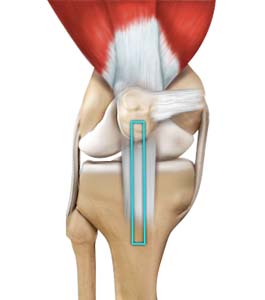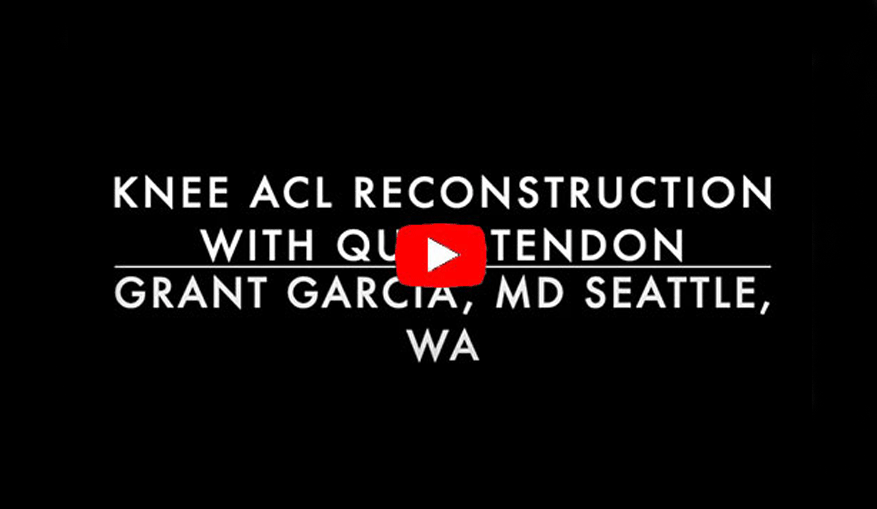ACL Reconstruction
Check out Dr. Garcia blog on ACL graft options.
-
Introduction to innovations in ACL reconstruction surgery
-
Further Innovations in ACL Reconstruction Surgery
Understanding ACL Tears and Reconstruction: Your Complete Guide
-
Dr. Garcia talks about RTS after ACL injury in the NFL on NYSEA sports radio.
-
Check out the future of sports medicine as Dr. Garcia discusses upcoming technology we are using to improve our outcomes and get our athletes back faster.
Welcome to our comprehensive guide on ACL (Anterior Cruciate Ligament) tears and ACL reconstruction. As a patient, it's essential to have a clear understanding of these topics to make informed decisions about your health. In this article, we will explore what an ACL tear is, when ACL reconstruction is indicated, the risks and benefits of the procedure, expected outcomes, and other potential injuries associated with it.
What is an ACL Tear?
The anterior cruciate ligament is one of the major stabilizing ligaments in the knee. It is a strong rope like structure located in the center of the knee running from the femur to the tibia. When this ligament tears unfortunately, it does not heal and often leads to the feeling of instability in the knee.
ACL reconstruction is a commonly performed surgical procedure and with recent advances in arthroscopic surgery can now be performed with minimal incision and low complication rates. The advancements in arthroscopic surgery make it easy for surgeons to see and work on knee structures through small incisions. Repair of the torn ligament can be performed at the same time as the diagnostic arthroscopy with fewer surgical risks.
The surgery can usually be done as an outpatient procedure which means you may be discharged to go home on the same day as the procedure.
Dr. Garcia speaking about ACL reconstruction on 710 ESPN Radio
Causes
An ACL injury most commonly occurs during sports that involve twisting or overextending your knee. An ACL can be injured in several ways:
- Sudden directional change
- Slowing down while running
- Landing from a jump incorrectly
- Direct blow to the side of your knee, such as during a football tackle
Recent ACL Webinar with MoveMend Rehab
Symptoms
When you injure your ACL, you might hear a loud "pop" sound and you may feel the knee buckle. Within a few hours after an ACL injury, your knee may swell due to bleeding from vessels within the torn ligament. You may notice that the knee feels unstable or seems to give way, especially when trying to change direction on the knee.
Diagnosis
An ACL injury can be diagnosed with a thorough physical examination of the knee and diagnostic tests such as X-rays, MRI scans and arthroscopy. X-rays may be needed to rule out any fractures. In addition, your doctor will often perform the Lachman’s test to see if the ACL is intact. During a Lachman test, knees with a torn ACL may show increased forward movement of the tibia and a soft or mushy endpoint compared to a healthy knee.
Pivot shift test is another test to assess ACL tear. During this test, if the ACL is torn, the tibia will move forward when the knee is completely straight and as the knee bends past 30° the tibia shifts back into correct place in relation to the femur.
Indications for ACL Reconstruction
ACL tears are not always treated with surgery. The decision to undergo ACL reconstruction depends on several factors, including:
- Activity Level: Patients who engage in activities that require knee stability, such as sports, may be more inclined to undergo surgery to restore their knee's functionality.
- Age: Younger patients may be recommended for ACL reconstruction due to a longer expected lifetime of knee use.
- Severity of Tear: The extent of the ACL tear and its impact on the knee's stability play a significant role in the decision-making process.
- Lifestyle: Patients who desire a quick return to sports or an active lifestyle may opt for surgery.
- Associated Injuries: The presence of other injuries in the knee, such as meniscus tears or cartilage damage, can influence the decision to undergo ACL reconstruction.
ACL Tears and Surgical Options
Risks and Benefits of ACL Reconstruction
Risks:
- Infection: As with any surgery, there is a risk of infection. Surgical sites are meticulously prepared to minimize this risk, but it can still occur.
- Bleeding: Excessive bleeding during surgery is rare, but it is a possible complication.
- Graft Failure: In some cases, the graft used to replace the torn ACL may not heal correctly, leading to graft failure.
- Stiffness: Post-surgery, some patients experience stiffness in the knee joint, which may require additional rehabilitation.
- Nerve and Blood Vessel Damage: Though rare, injury to nearby nerves or blood vessels can occur during surgery.
Benefits:
- Restored Knee Stability: ACL reconstruction aims to restore the stability of the knee joint, reducing the risk of further injury.
- Pain Relief: Many patients experience a significant reduction in pain following successful surgery.
- Improved Functionality: ACL reconstruction can help patients return to their previous levels of activity and regain functionality in their knee.
- Prevention of Additional Injuries: Restoring knee stability through surgery can reduce the risk of other injuries, such as meniscus tears or cartilage damage.
- Return to Sports: For athletes, ACL reconstruction can often facilitate a return to their sport of choice.
ACL Surgery Recovery and Return to Sport Questions Answers with Grant Garcia MD and Mitch Owens PT
Expected Outcomes
ACL reconstruction is a well-established procedure with a high success rate. However, the outcome can vary from patient to patient. Here are some general expectations:
- Rehabilitation: The recovery process involves physical therapy and rehabilitation. It may take several months to regain full knee strength and function.
- Return to Sports: Athletes may need six months or more before safely returning to their sport. This timeline varies depending on individual progress and the type of sport.
- Long-Term Outlook: With successful surgery and diligent rehabilitation, most patients can expect a favorable long-term outlook. However, it's essential to follow post-surgery instructions and take precautions to prevent re-injury.
Check out our most recent video blog for ACL tears in conjunction with Rehab United.
Other Injuries Associated with ACL Tears
When an ACL tear occurs, it can often be accompanied by other injuries within the knee joint:
- Meniscus Tears: The menisci are cartilage structures in the knee that can also be injured during an ACL tear. Meniscus tears can cause pain, swelling, and limited range of motion.
- Cartilage Damage: : The articular cartilage, which covers the ends of the bones in the knee joint, can be damaged when the ACL tears. This can lead to joint pain and arthritis over time.
- Ligament Injuries: In addition to the ACL, other ligaments in the knee, such as the medial collateral ligament (MCL) or lateral collateral ligament (LCL), can be injured during a traumatic event.
- Bone Bruises: These are areas of bone damage that can occur during an ACL tear, causing additional pain and discomfort.
- Tendon Injuries: In some cases, the tendons around the knee may also be damaged.
Introduction to ACL Reconstruction Graft Options
ACL reconstruction is a surgical procedure in which a graft is used to replace the damaged or torn ACL. Grafts are usually harvested from either the patient's own body (autograft) or from a donor (allograft). Each graft type has its own advantages and disadvantages, which I will explain in detail below.
Graft Types for ACL Reconstruction
1. Patellar Tendon Allograft ACL Reconstruction: Advantages, Outcomes, and Rehabilitation Benefits
In this dedicated section, we will explore the benefits of ACL (Anterior Cruciate Ligament) reconstruction using a patellar tendon allograft, highlighting its advantages and the rehabilitation benefits it offers to patients.
Patellar Tendon Allograft: An Overview
Patellar tendon allograft is a surgical technique for ACL reconstruction that involves using a cadaveric (donor) patellar tendon as the graft material. This approach offers unique advantages for patients considering ACL reconstruction:
- No Secondary Donor Site: Since the graft is obtained from a donor, there is no need for a secondary donor site surgery on the patient's body, reducing potential pain and complications associated with harvesting the graft from the patient.
- Graft Availability: Patellar tendon allografts are readily available, ensuring that patients have access to suitable grafts when needed.
- Reduced Recovery Time: Patients may experience a quicker recovery time and less pain at the graft site compared to autograft options like the patellar tendon or hamstring graft.
Benefits of Patellar Tendon Allograft ACL Reconstruction
Now, let's explore the specific advantages and rehabilitation benefits associated with patellar tendon allograft ACL reconstruction:
- Reduced Donor Site Morbidity: Since there is no need to harvest tissue from the patient, they are spared from potential complications and pain at the donor site, which can be a concern with autografts.
- Early Rehabilitation Advantages: Patellar tendon allograft recipients often experience a more comfortable and faster rehabilitation process due to reduced pain at the graft site. This can lead to an earlier return to daily activities and sports.
- Comparable Strength and Stability: Studies have shown that patellar tendon allografts provide strength and stability similar to that of autografts, making them a reliable option for ACL reconstruction.
- No Compromise in Long-Term Outcomes: Research indicates that patients who undergo ACL reconstruction with patellar tendon allografts achieve comparable long-term outcomes in terms of stability, return to sports, and knee function.
Rehabilitation Benefits
The rehabilitation process following ACL reconstruction with a patellar tendon allograft offers several advantages:
- Early Mobilization: Patients can typically initiate early rehabilitation and range of motion exercises due to reduced pain at the graft site.
- Faster Progression: The decreased pain associated with patellar tendon allografts allows for a faster progression through rehabilitation milestones, including strengthening exercises and functional training.
- Reduced Risk of Muscle Atrophy: Patients are less likely to experience muscle atrophy, as they can engage in early weight-bearing activities and strengthening exercises, contributing to improved overall knee function.
- Enhanced Compliance: Patients may find the rehabilitation process more comfortable, leading to better compliance with their rehabilitation program and ultimately better outcomes.
Outcomes of Patellar Tendon Allograft ACL Reconstruction
Several outcome studies and research findings support the effectiveness of patellar tendon allograft ACL reconstruction:
- Comparable Stability: A study published in the "American Journal of Sports Medicine" (2019) found that patients who received patellar tendon allografts achieved comparable knee stability and functional outcomes to those with autografts.
- High Return to Sport Rates: Research published in the "Journal of Orthopaedic & Sports Physical Therapy" (2021) reported high rates of return to sports and activities among patients who underwent ACL reconstruction with patellar tendon allografts.
- Favorable Long-Term Outcomes: Studies with long-term follow-up have shown that patients with patellar tendon allografts maintain knee stability and function over extended periods.
Conclusion
ACL reconstruction using a patellar tendon allograft offers unique advantages for patients, including reduced donor site morbidity, faster rehabilitation progression, and comparable long-term outcomes. The rehabilitation process is often more comfortable and can lead to an earlier return to daily activities and sports.
ACL Reconstruction Hamstring Method
2. Hamstring Graft
The hamstring graft is one of the most used autografts for ACL reconstruction. It involves taking a portion of the patient's hamstring tendons (located at the back of the thigh) to create the graft. Here are the pros and cons of the hamstring graft:
Advantages
- Lower risk of anterior knee pain: Patients who undergo hamstring grafts often experience less anterior knee pain compared to those who receive patella tendon grafts.
- Smaller incisions: Hamstring grafts require smaller incisions, which can result in less scarring and a faster recovery time.
Disadvantages
- Slightly weaker initial graft strength: Hamstring grafts may have slightly lower initial strength compared to other grafts, which could affect the early stages of rehabilitation.
- Risk of hamstring weakness: Harvesting hamstring tendons can lead to hamstring weakness, which may impact activities like running and jumping, particularly in the first few months after surgery.
3. Quad Tendon Autograft ACL Reconstruction: Proven Benefits and Outcomes
In this segment, we will delve into the details of this surgical procedure, exploring its advantages and providing insight into outcome studies that validate its benefits.
Dr. Garcia’s Updated Quad ACL Reconstruction Technique
Brand New Arthrex Soft Tissue Button Quad ACL Surgery – First in Washington State
Quad Tendon ACL graft prep
Quad Tendon Autograft: An Overview
Quad tendon autograft is a surgical technique used for ACL (Anterior Cruciate Ligament) reconstruction. It involves utilizing a portion of the patient's own quadriceps tendon, which runs from the kneecap to the shinbone, as the graft material. This graft option has gained popularity among orthopedic surgeons for several reasons:
- Graft Strength: The quad tendon provides robust and strong graft tissue, which is particularly beneficial for individuals with high activity levels or athletes who rely on knee stability.
- Reduced Risk of Hamstring Weakness: Unlike hamstring grafts, harvesting the quad tendon does not carry the risk of hamstring weakness, which can impact activities like running and jumping, especially in the early stages of recovery.
- Excellent Graft Thickness: The quad tendon is often thicker than some other graft options, contributing to its durability and stability after surgery.
Benefits of Quad Tendon Autograft ACL Reconstruction
Advancements in Quad ACL Reconstruction: Speed Closure Technique
Let's explore the specific benefits of choosing the quad tendon autograft for ACL reconstruction:
- Strong and Reliable: Research has consistently demonstrated that quad tendon autografts provide excellent biomechanical strength and stability when used for ACL reconstruction. This strength is crucial for patients who wish to return to high-demand sports or activities.
- Faster Recovery: Patients undergoing quad tendon autograft ACL reconstruction often experience a quicker return to full functionality. This is attributed to the robust nature of the graft tissue and its ability to withstand the stresses of early rehabilitation.
- Reduced Risk of Hamstring Issues: Since the graft is harvested from the front of the thigh (quadriceps tendon), there is no risk of hamstring weakness or complications associated with hamstring grafts. This can be particularly appealing for athletes who rely on strong hamstring function.
- Lower Risk of Anterior Knee Pain: Some studies suggest that patients who undergo quad tendon autograft ACL reconstruction experience less anterior knee pain compared to those with patella tendon grafts. This can enhance the overall post-operative experience.
Outcome Studies on Quad Tendon Autograft ACL Reconstruction
Outcome studies play a crucial role in validating the effectiveness of surgical techniques and graft choices. Here are key findings from select studies that highlight the benefits of quad tendon autograft ACL reconstruction:
- Superior Biomechanical Strength: A study published in the "American Journal of Sports Medicine" (2018) compared various graft types and found that quad tendon autografts exhibited superior biomechanical strength, indicating increased graft stability and reliability during movement.
- Lower Risk of Complications: Research published in the "Journal of Knee Surgery" (2019) reported a lower rate of complications, including graft rupture, in patients who received quad tendon autografts when compared to other graft types.
- Improved Post-Operative Functionality: A study published in the "British Journal of Sports Medicine" (2017) followed patients who underwent quad tendon autograft ACL reconstruction and noted significant improvements in knee functionality and return to sports when compared to hamstring graft recipients.
- Decreased Anterior Knee Pain: Several studies have highlighted a reduced incidence of anterior knee pain in patients who received quad tendon autografts. This is attributed to the unique characteristics of the graft tissue and its compatibility with the knee joint.
Conclusion
Quad tendon autograft ACL reconstruction is a surgical technique that has consistently demonstrated its benefits and advantages in numerous outcome studies. Patients seeking a strong and reliable graft option, faster recovery, and a reduced risk of complications should consider discussing this technique with their orthopedic surgeon.
**Ultimately, the choice of graft type should be based on individual patient factors and goals, and it should be made in consultation with a qualified orthopedic surgeon. Your surgeon will assess your specific needs and recommend the most suitable graft option to help you achieve the best possible outcome following ACL reconstruction.
ACL Reconstruction Patellar Tendon
4. Patellar Tendon Autograft ACL Reconstruction: Optimizing Outcomes for Athletes
Dr. Garcia’s technique for Patella Tendon (BTB) ACL surgery, a great option for high level athletes.
In this dedicated section, we will explore the benefits of ACL (Anterior Cruciate Ligament) reconstruction using a patellar tendon autograft, particularly focusing on its advantages for athletes. We'll delve into the outcomes and literature supporting this surgical technique.
Patellar Tendon Autograft: A Closer Look
Patellar tendon autograft is a well-established surgical technique for ACL reconstruction. It involves harvesting a portion of the patient's patellar tendon, which connects the kneecap (patella) to the shinbone (tibia), to serve as the graft material. This graft option offers several notable advantages, especially for individuals with active and athletic lifestyles:
- Strength and Durability: The patellar tendon is known for its strength and durability, making it an ideal choice for athletes who demand robust knee stability to return to their sports.
- Rapid Healing: Patellar tendon grafts tend to heal quickly, enabling athletes to embark on a faster road to rehabilitation and a quicker return to their sports or activities.
- Low Risk of Graft Failure: Studies have consistently shown that patellar tendon autografts have a historically low risk of graft failure, which is essential for athletes seeking long-term knee stability.
- Enhanced Stability: Due to the patellar tendon's thickness and strength, it provides excellent stability and is less likely to stretch or become lax over time.

Benefits of Patellar Tendon Autograft ACL Reconstruction for Athletes
Now, let's delve into the specific advantages that make patellar tendon autograft ACL reconstruction an appealing choice for athletes:
- Superior Athletic Performance: The strength and stability provided by the patellar tendon autograft allow athletes to regain their pre-injury level of performance more effectively. It is especially valuable for sports that involve cutting, pivoting, and quick direction changes, like basketball, soccer, and football.
- Reduced Risk of Re-Injury: The graft's durability and low risk of failure contribute to a reduced risk of re-injury, providing athletes with greater confidence and peace of mind when returning to their sports.
- Faster Return to Sports: Athletes often experience a quicker return to their respective sports with patellar tendon autograft ACL reconstruction due to the graft's ability to withstand the demands of early rehabilitation and training.
- Long-Term Knee Health: The graft's ability to maintain knee stability over the long term can help preserve the athlete's knee joint, potentially reducing the risk of osteoarthritis and other knee-related issues in the future.
ACL Patella Tendon Reconstruction with Tightrope and Internal Brace.
Outcome Studies and Literature on Patellar Tendon Autograft ACL Reconstruction
Outcome studies are essential in evaluating the success and efficacy of surgical techniques. Numerous studies have been conducted to assess the benefits of patellar tendon autograft ACL reconstruction for athletes:
- Improved Functional Outcomes: A study published in the "Journal of Sports Medicine and Physical Fitness" (2019) reported that athletes who underwent patellar tendon autograft ACL reconstruction exhibited significantly improved functional outcomes and sports-specific performance when compared to other graft types.
- Reduced Re-Injury Rates: Research published in the "American Journal of Sports Medicine" (2018) found that athletes who received patellar tendon autografts had lower rates of graft rupture and re-injury, reinforcing the graft's stability and durability.
- High Return to Sport Rates: A comprehensive meta-analysis published in the "British Journal of Sports Medicine" (2020) indicated that athletes who underwent patellar tendon autograft ACL reconstruction had higher return to sport rates, showcasing the graft's effectiveness in facilitating a successful return to athletic activities.
- Lower Risk of Knee Laxity: Several studies have demonstrated that patellar tendon autografts provide superior knee stability, resulting in lower post-operative knee laxity compared to alternative graft options.
Dr. Garcia demonstrates the new Arthrex BTB Fibersnare
Choosing the Right Graft Type
The choice of graft type for ACL reconstruction is not one-size-fits-all. It depends on various factors, including your age, activity level, overall health, and personal preferences. Here are some key considerations to discuss with your orthopedic surgeon:
- Activity Level: If you are an athlete or have high activity demands, you may benefit from a stronger graft like the quad tendon or patella tendon graft.
- Anterior Knee Pain Tolerance: Consider your tolerance for potential anterior knee pain. If you have a low tolerance, hamstring or quad tendon grafts might be preferable.
- Recovery Time: Your occupation and lifestyle can affect your choice. If you need a quicker return to work or sports, a graft with a faster recovery time may be recommended.
- Overall Health: Your surgeon will consider your overall health when recommending a graft type. For example, if you have weakened hamstring tendons or a history of knee issues, certain grafts may be more suitable.
- Surgeon's Expertise: Your surgeon's experience and preference also play a role. They will likely recommend a graft type they are most comfortable working with.
Conclusion
In conclusion, ACL reconstruction is a common procedure used to restore knee stability following ACL injuries. The choice of graft type, whether allograft, hamstring graft, quad tendon graft, or patella tendon graft, should be made in consultation with your orthopedic surgeon. Each graft type has its own set of advantages and disadvantages, and the decision should consider your individual needs and goals.
Remember, successful ACL reconstruction requires not only choosing the right graft but also diligent rehabilitation and post-operative care. Your surgeon will provide you with a tailored treatment plan to help you recover and regain full function of your knee. If you have any questions or concerns, do not hesitate to discuss them with your orthopedic surgeon, who will guide you through the entire process, from pre-surgery preparations to post-surgery rehabilitation.
ACL Reconstruction with Quadriceps Tendon Allograft
A strong, consistent graft option ideal for revision ACL surgery and active adults 35+
When an ACL tear leads to persistent instability-or when a previous ACL reconstruction has failed-a reliable graft choice becomes essential. For patients over 35 and those undergoing revision ACL reconstruction, the quadriceps tendon allograft is one of the most effective modern graft options available.
This graft uses donor quadriceps tendon to recreate the ACL, offering strength, consistent sizing, and less postoperative pain without the morbidity of tendon harvesting.
Why Choose a Quadriceps Tendon Allograft?
1. Strong, Durable Graft with Excellent Biomechanics
The quadriceps tendon is thick, robust, and biomechanically reliable. Its large cross-sectional area closely matches the strength profile of the native ACL-providing excellent stability for cutting, pivoting, and everyday functional movements.
2. No Donor-Site Morbidity
Because the graft comes from a donor, there is no tendon harvested from your own knee, avoiding:
- Quadriceps or hamstring weakness
- Kneeling pain
- Anterior knee pain
- Harvest-site soreness or numbness
This often leads to less pain early on and smoother rehabilitation, especially important for revision cases.
3. Ideal for Revision Surgery & Adults Over 35
Quadriceps tendon allograft is particularly advantageous for:
- Revision ACL reconstruction
- Patients over 35 seeking a stable, durable graft with faster early recovery
- Patients wanting to avoid additional incisions
- Individuals with prior hamstring or patellar tendon harvests
- Multi-ligament injuries requiring a high-volume graft
Its predictable size and structural reliability make it an excellent choice when previous grafts have failed or prior harvest sites limit autograft options.
4. Predictable Graft Size and Volume
Unlike autografts-especially hamstrings-where size may vary, quadriceps allografts offer consistent, pre-measured graft dimensions. This improves tunnel fit and may reduce the risk of graft stretch or early laxity in revision settings.
5. Less Postoperative Pain & Faster Initial Mobility
Without the additional trauma of autograft harvest, patients typically experience:
- Less early swelling
- Easier quadriceps activation
- Faster return to a normal walking pattern
- Improved comfort during the first 6–8 weeks
For active adults and revision patients, this can significantly improve early rehabilitation.
Who Is the Best Candidate for a Quad Tendon Allograft?
This graft is ideal for:
- Adults 35 and older returning to recreational sports or active lifestyles
- Revision ACL surgeries where graft durability and consistency are critical
- Patients with prior tendon harvests
- Those seeking less postoperative discomfort
- Patients who prefer shorter operative times with fewer incisions
My Approach
In my practice, quadriceps tendon allograft is a high-quality, reliable option for adults 35+ and revision ACL surgery. Using modern, anatomic techniques with low-profile fixation-and internal brace support when appropriate-I prioritize graft stability, smooth recovery, and long-term durability.
-
Our technique for ACL reconstruction with a lateral meniscus root repair.
-
Technique for combined ACL reconstruction with a medial meniscus transplant
Dr. Garcia demonstrates his technique for Quad Tendon ACL reconstruction.






















